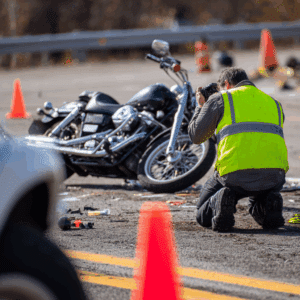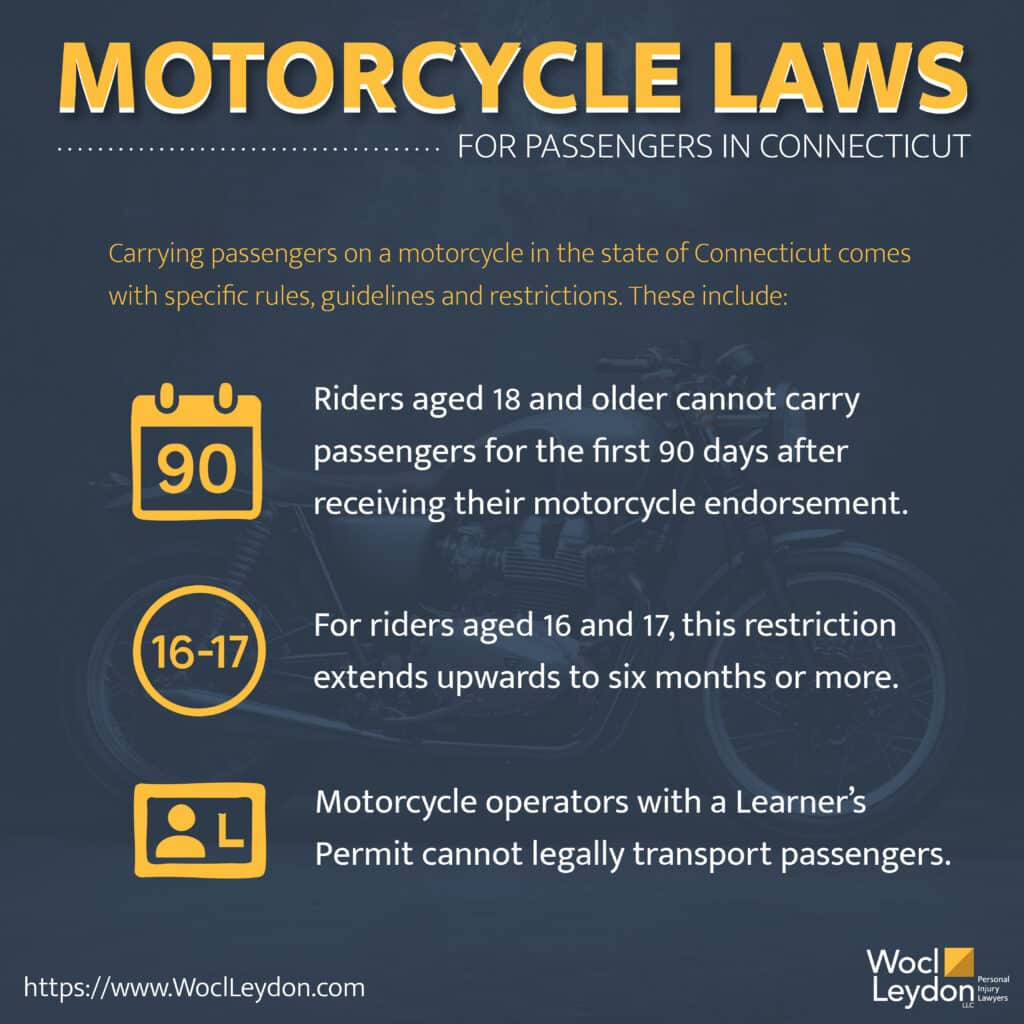Motorcycle Accident Laws in Connecticut: What You Need to Know
Last updated Thursday, September 4th, 2025

Caught in a motorcycle accident in Connecticut? Knowing the motorcycle accident laws in Connecticut can help you protect your rights and seek fair compensation. This article covers licensing requirements, helmet laws, lane usage rules, insurance needs, and legal liabilities. Equip yourself with the knowledge to navigate the aftermath of a motorcycle accident efficiently.
Key Takeaways
- Connecticut requires motorcycle riders to possess a motorcycle endorsement or learner’s permit, which involves completing tests and safety courses.
- Motorcyclists must wear helmets and eye protection per state law, with specific age restrictions and penalties for non-compliance.
- Consulting with motorcycle accident lawyers is crucial for navigating legal liability and maximizing compensation claims after an accident.

Get Your FREE Case Review,
In Person or Virtually Online
Connecticut Motorcycle Licensing Requirements
To legally ride a motorcycle in Connecticut, you must have either a motorcycle endorsement or a motorcycle learner’s permit. This ensures that riders possess the skills and knowledge needed to handle a motorcycle safely. Unlike a standard driver’s license, a separate motorcycle license or endorsement is specifically tailored to the unique demands of motorcycling.
A motorcycle learner’s permit involves the following conditions and steps:
- It is initially valid for 60 days.
- It can be renewed once within the same calendar year.
- Applicants under 18 need a notarized parental consent certificate.
- Upon passing the knowledge and vision tests, applicants receive their learner’s permit by mail within 20 business days.
To upgrade from a learner’s permit to a full motorcycle endorsement, the following are required:
- Completing an approved motorcycle safety course
- Paying a required fee of $40 for the knowledge and vision tests
- Paying an additional $30 to add the motorcycle endorsement to your Connecticut driver’s license
Helmet and Eye Protection Laws
Safety is paramount when riding a motorcycle. Connecticut law requires operators and passengers under 18, as well as those with a learner’s permit, to wear a helmet. Non-compliance can lead to penalties ranging from $35 to $90, depending on the offense. The helmet law and the mandatory helmet law apply to all motorcycles, regardless of engine size or speed.
Helmets aren’t the only mandated gear; all motorcyclists must wear eye protection, including a face shield, unless their motorcycle has a windshield. This requirement helps prevent debris and insects from impairing vision, which is crucial for maintaining control of the motorcycle.
While penalties for not wearing a helmet can add up, the real cost is the risk to your safety. A helmet can significantly reduce injury severity in a motorcycle accident, making it both a legal requirement and a life-saving measure.
Lane Usage and Lane Splitting Regulations
Navigating traffic can be challenging for motorcyclists, making adherence to Connecticut’s lane usage regulations crucial to avoid accidents and legal issues. Lane splitting, or riding between lanes of slow or stopped traffic, is illegal in Connecticut. The prohibition aims to ensure the safety of all road users.
Motorcyclists must stay within their designated lanes, and riding side-by-side in a single lane is not permitted. Passing other motor vehicles and cars within the same lane is also forbidden. These rules minimize collision risks and ensure predictable traffic flow.
Using the shoulder of the road as a travel lane is illegal in Connecticut. Filtering through stopped traffic at red lights, common in some states, is not allowed. Following these regulations maintains road order and reduces motorcycle accident risks.

Get Your FREE Case Review,
In Person or Virtually Online
Insurance Requirements for Motorcyclists
Having the right insurance is both a legal obligation for Connecticut motorcyclists and a safeguard against financial losses. The state mandates that motorcyclists carry minimum liability insurance covering bodily injury and property damage. The minimum liability coverage required is $25,000 for individual bodily injury, $50,000 for multiple bodily injuries, and $25,000 for property damage.

Failure to maintain required insurance can have severe consequences:
- Insurance companies must report coverage lapses to the DMV.
- This leads to a warning notice and a $200 fine to prevent registration suspension.
- Persistent non-compliance may result in fines, registration suspension, and even motorcycle impoundment, along with additional offenses.
Legal Liability in Motorcycle Accidents
Understanding legal liability is vital for any motorcyclist involved in an accident in Connecticut. Connecticut uses an ‘at-fault’ insurance system, meaning the responsible party is liable for the damages. This system allows victims to hold the at-fault driver accountable and seek compensation for their losses.
Connecticut’s modified comparative negligence law includes the following key points:
- Injured parties can seek damages even if they are partly at fault, as long as they are not more than 50% at fault.
- Compensation is reduced based on the injured party’s percentage of fault.
- There are no caps on injury damages, allowing victims to potentially recover significant amounts depending on the circumstances.
Motorcycle accident lawyers are essential in these cases. They specialize in traffic laws and insurance regulations related to motorcycle incidents. By gathering evidence and establishing liability, these attorneys support the victim’s case and help navigate the complex process of recovering damages in a motorcycle accident lawsuit.
Safety Equipment and Gear
For motorcycle riding, safety equipment is not just an option—it’s a necessity. Protective gear like:
- Helmets
- Gloves
- Jackets
- Boots are crucial for minimizing injuries in a motorcycle accident. Investing in high-quality equipment can significantly enhance your safety on the road.
The Connecticut Rider Education Program emphasizes using appropriate safety equipment and developing riding skills to enhance motorcyclist safety. Wearing a helmet can greatly reduce the risk of head injuries, while gloves and jackets protect against road rash.
Road safety combines wearing the right gear and being aware of your surroundings to stay safe. Taking these precautions can significantly reduce injury risk and enhance the riding experience.
After the restriction period, operators must ensure their motorcycles are equipped to carry passengers, including having a firmly attached seat. There are no age restrictions for passengers in Connecticut, allowing flexibility for families and friends to ride together. Additionally, it is important to be aware of Connecticut motorcycle laws.
Understanding these rules ensures both the operating operator and passenger can operate safely and comply with motorcycle laws. Properly equipped motorcycles and adherence to these regulations can prevent accidents and improve the overall riding experience.
Steps to Take After a Motorcycle Accident
An accident can be traumatic, but knowing the steps to take afterward can significantly impact your recovery and legal standing. The first step is to contact the police to fulfill legal obligations and gather evidence for any compensation claim. Leaving the scene before authorities arrive can have legal consequences.
Prompt medical attention is vital, as some serious injuries may not be immediately apparent. Early treatment ensures your health and provides essential documentation for your claim.
Documenting the accident by collecting contact details from other drivers and witnesses and noting all relevant details while fresh in your memory is crucial. These steps build a solid foundation for future legal actions and ensure you are protected both medically and legally.

Get Your FREE Case Review,
In Person or Virtually Online
Seeking Compensation for Injuries and Damages
Seeking compensation for injuries and damages after a motorcycle accident is a critical step in your recovery process to recover compensation. Victims can seek compensation for:
- Medical expenses
- Lost wages
- Property damage
- Vehicle damage
- Pain and suffering
However, avoid making statements to the other party’s insurance company without legal counsel, as these can be used against you in future claims.
Refrain from signing any documents from the opposing insurance company without consulting your attorney, as this may limit your rights to further claims. Lawyers play a pivotal role in negotiating with insurance companies to secure fair compensation for their clients’ medical expenses and damages. If necessary, they represent clients in court to ensure proper case presentation and protect their rights.
Many motorcycle accident lawyers operate on a contingency fee basis, allowing victims to obtain legal services without upfront costs, making it easier to obtain deserved compensation.
Importance of Legal Representation
Having experienced personal injury attorneys can make a world of difference after a motorcycle accident. Understanding your rights and legal recourse is the first step in protecting yourself. Guidance from experienced personal injury attorneys helps victims navigate the legal process and maximize compensation.
After seeking medical care for injuries from a motorcycle accident, follow these steps:
- Schedule a free consultation with a Connecticut motorcycle accident lawyer.
- Consult the motorcycle accident attorney to enhance your understanding of the situation.
- Work with the attorney to assist in maximizing your compensation.
These professionals offer valuable insights and legal options that can significantly impact your legal rights and case outcome, ensuring you receive the justice and compensation you deserve.
Frequently Asked Questions
Do I need a separate motorcycle license to ride in Connecticut?
Yes, in Connecticut, you must have a motorcycle endorsement or a motorcycle learner’s permit to legally operate a motorcycle.
What are the penalties for not wearing a helmet in Connecticut?
In Connecticut, riders under 18 and those with a learner’s permit must wear a helmet; failure to comply can result in fines between $35 and $90.
Is lane splitting legal in Connecticut?
Lane splitting is not legal in Connecticut; motorcyclists are required to remain in their designated lanes without passing other vehicles in the same lane.
What insurance is required for motorcyclists in Connecticut?
Motorcyclists in Connecticut are required to carry minimum liability insurance, which includes bodily injury and property damage coverage, along with uninsured/underinsured motorist coverage.
What should I do immediately after a motorcycle accident?
Immediately after a motorcycle accident, you should contact the police, seek medical attention if needed, and document the incident by collecting contact information from other drivers and witnesses. This ensures your safety and helps establish the details of the accident.
Related Article


